Marine Hull Protective Device and Associated Methods
- Summary
- Abstract
- Description
- Claims
- Application Information
AI Technical Summary
Benefits of technology
Problems solved by technology
Method used
Image
Examples
Embodiment Construction
[0017]A description of the preferred embodiments of the present invention will now be presented with reference to FIGS. 1-7.
[0018]The present invention is directed to a devices and methods for protecting a hull 10 of a marine vessel 11. The hull-protective device 12 in an embodiment (FIGS. 1-4) comprises a cover base 13 comprising flexible sheet 14 of water-impermeable material. The flexibility of the sheet 14 assists in preventing the attachment of barnacles thereto, since such organisms typically require a rigid or semi-rigid surface on which to reside. The sheet 14 is dimensioned to closely conform to at least a water-contacting portion of the hull 10.
[0019]A sheet blank 14 for the cover base (FIG. 4) has substantially parallel side edges 15. A top edge 16 has a curved notch 17 therein, wherein the edges 18 of the notch 17 are sealable to form a boat-hull-conforming fore portion 19. A bottom edge 20 opposed to the top edge 16 has opposed outer portions 21 that are substantially p...
PUM
 Login to View More
Login to View More Abstract
Description
Claims
Application Information
 Login to View More
Login to View More - R&D
- Intellectual Property
- Life Sciences
- Materials
- Tech Scout
- Unparalleled Data Quality
- Higher Quality Content
- 60% Fewer Hallucinations
Browse by: Latest US Patents, China's latest patents, Technical Efficacy Thesaurus, Application Domain, Technology Topic, Popular Technical Reports.
© 2025 PatSnap. All rights reserved.Legal|Privacy policy|Modern Slavery Act Transparency Statement|Sitemap|About US| Contact US: help@patsnap.com



